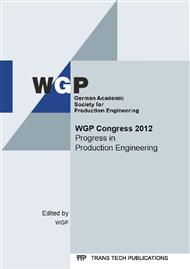[1]
Schuh G, Stoelzle W, Straube F (editor) (2008) Anlaufmanagement in der Automobilindustrie erfolgreich umsetzen. Springer, Berlin, Heidelberg.
DOI: 10.1007/978-3-540-78407-4
Google Scholar
[2]
Schuh G, Kampker A (editor) (2011) Strategie und Management produzierender Unternehmen. Springer, Berlin, Heidelberg.
Google Scholar
[3]
DIN Deutsches Institut für Normung e.V. (2005) ISO 9000: Quality management systems - Fundamentals and Vocabulary. trilingual version. Beuth, Berlin.
Google Scholar
[4]
Bundesministerium für Wirtschaft und Technologie (2006) BMWI Energierohstoffbericht. http: /www. bmwi. de/BMWi/Redaktion/PDF/E/energierohstoffbericht, property=pdf, bereich=bmwi, sprache=de, rwb=true. pdf. Accessed 20 March (2012).
DOI: 10.1515/9783110505405-004
Google Scholar
[5]
Ashby M, Jones D (2006) Engineering Materials 1 - An introduction to properties, applications and designs. Elsevier Ltd.
Google Scholar
[6]
United States Geological Survey (USGS) (2012) Iron Ore - Statistics and Information. http: /minerals. usgs. gov/minerals/pubs/commodity/iron_ore/mcs-2012-feore. pdf. Accessed 09 March (2012).
Google Scholar
[7]
Bundesagentur für Geowissenschaft und Rohstoffe (2006).
Google Scholar
[8]
United States Geological Survey (USGS) (2012) Commodity - Statistics and Information. Statistics and information on the worldwide supply of, demand for, and flow of minerals and material. Accessed 09 March (2012).
Google Scholar
[9]
European Union (2007).
Google Scholar
[10]
European Union (2004).
Google Scholar
[11]
European Union (2006) Directive 2006/26/EC on energy end-use efficiency and energy services. Official Journal of the European Union. http: /ec. europa. eu/. Accessed 20 March (2012).
Google Scholar
[12]
European Union (2009) Directive 2009/125/EC on establishing a framework for the setting of eco design requirements for energy-related products. http: /ec. europa. eu/. Accessed 20 March (2012).
Google Scholar
[13]
International Organization for Standardization (2011) ISO/CD 14955: Machine tools - Environmental evaluation of machine tools - Part 1: Design methodology for energy-efficient machine tools. Geneva.
DOI: 10.3403/30333287
Google Scholar
[14]
California Air Resources Board (CARB) (2012) The California Low-Emission Vehicle Regulations. http: /www. arb. ca. gov/msprog/levprog/cleandoc/cleancomplete_lev-ghg_regs_12-10. pdf, Accessed 16 March (2012).
Google Scholar
[15]
Environmental Protection Agency (EPA) (2012) Emission Standards Reference Guide. http: /www. epa. gov/otaq/standards/allstandards. htm, Accessed 16 March (2012).
Google Scholar
[16]
Unmueßig B, Cramer S (2008) Climate Change in Africa. GIGA Focus. German Institute of Global Area Studies (Publ. ). www. giga-hamburg. de/giga-focus. Accessed 09 March (2012).
DOI: 10.1163/1872-9037_afco_asc_1224
Google Scholar
[17]
Harmeling S (2012) Global Climate Risk Index 2012. Briefing Paper. http: /www. germanwatch. org/klima/cri. pdf. Accessed 12 March (2012).
Google Scholar
[18]
Saikawa E, et. al. (2011) The impact of China's vehicle emissions on regional air quality in 2000 and 2020: a scenario analysis. Atmospheric Chemistry and Physics. 11/18: 9465-9484.
DOI: 10.5194/acp-11-9465-2011
Google Scholar
[19]
Kuhrke B, Erdle F (2010) Energieeffizienz als Investitionsentscheidung. Werkstatt und Betrieb 01-02: 30-33.
Google Scholar
[20]
de Chiffre L, Tosello G, Píska M, Müller (2009) Investigation of the reaming process using minimal quantity lubrication. CIRP Journal of Manufacturing Science and Technology. doi: 10. 1016/j. cirpj. 2009. 08. 004.
DOI: 10.1016/j.cirpj.2009.08.004
Google Scholar
[21]
Milberg J, Sigl M (2008) Electron sintering of metal power. Production Engineering. Springer, Berlin, 2: 117-122.
Google Scholar
[22]
Devoldere T, Dewulf W, Deprez W et al (2007).
Google Scholar
[23]
Neugebauer R, Wabner M, Rentzsch, Ihlenfeld S (2001) Structure princibles of energy efficient machine tools. CIRP Journal of Manufacturing Science and Technology. doi: 10. 1016/j. cirpj. 2011. 06. 017.
DOI: 10.1016/j.cirpj.2011.06.017
Google Scholar
[24]
Brecher C, Boos W, Klein W et al (2009) Ressourceneffizienzbewertung einer Werkzeugmaschine zur Steigerung ihrer Wirtschaftlichkeit. ZWF 104/9: 711-715.
DOI: 10.3139/104.110151
Google Scholar
[25]
Rebhan E (2002) Energiehandbuch – Gewinnung, Wandlung und Nutzung von Energie. Springer, Berlin.
Google Scholar
[26]
Blank S, Kormann G, Berns K (2011) A Modular Sensor Fusion Approach for Agricultural Machines. Proceedings of the XXXVI CIOSTA & CIGR Section V Conference. Vienna, Austria.
Google Scholar
[27]
Wiedemann J (2006) Leichtbau – Elemente und Konstruktion. Springer, Berlin.
Google Scholar
[28]
Dogan E, Steg L, Delhomme P (2011) The influence of multiple goals on driving behavior: The case of safety, time saving, and fuel saving. Accident Analysis & Prevention. 43/5: 1635–1643.
DOI: 10.1016/j.aap.2011.03.002
Google Scholar
[29]
Schmidt M (2011) Energie- und Stoffstromanalyse. RKW Rationalisierungs- und Innovationszentrum der Deutschen Wirtschaft e.V. Kompetenzzentrum, Faktenblatt: 1/(2011).
Google Scholar
[30]
DIN Deutsches Institut für Normung e.V. (2006) DIN EN ISO 14040: Environmental Management – life cycle assessment – Principles and framework. trilingual version. Beuth, Berlin.
Google Scholar
[31]
VDI Verein Deutscher Ingenieure e.V. (2012) VDI-Richtlinie 4600: Cumulative energy demand (KEA) - Terms, definitions, methods of calculation. Issue German/English. Beuth, Berlin.
Google Scholar
[32]
Erlach K, Westkämper E (editor) (2009) Energiewertstrom – Der Weg zur effizienten Fabrik. Fraunhofer Verlag, Stuttgart.
Google Scholar


